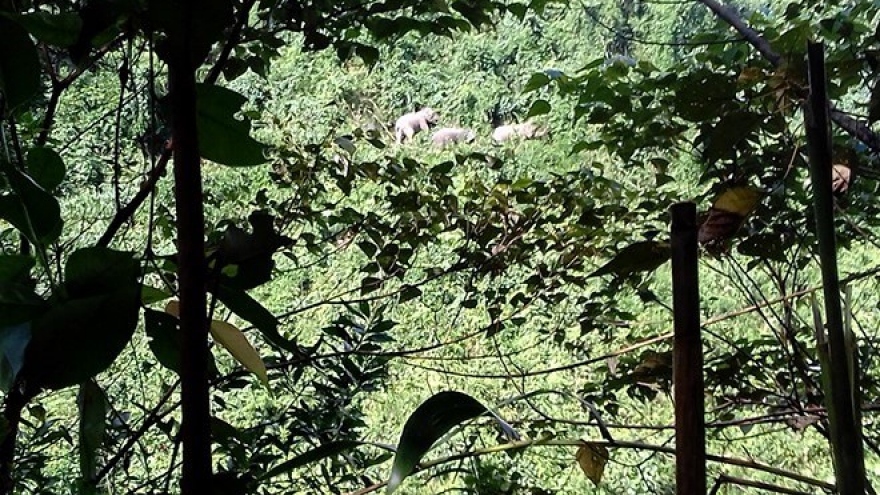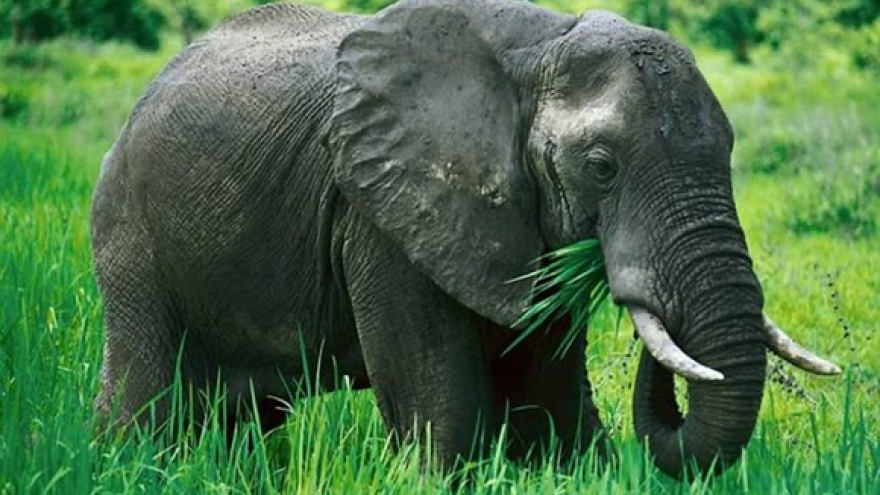Hungry wild elephants trash crops, property
Monday, 16:44, 27/03/2017
Wild elephant habitats in the southern province of Dong Nai are being reduced and degraded, leading to a lack of food and more conflicts between animals and humans, according to local authorities.
Experts say the elephant requires a vast habitat but its living space has been shrunk due to human encroachment into the forest. Local foresters in Dong Nai say the natural habitat for wild Asian elephants has shrunk from 50,000ha in the 1990s to 34,000ha in 2009.
Over the past few months, elephants have reportedly been approaching households in Dinh Quan district to search for food, destroying their crops and assets.
Nguyen Van Khoi, a farmer in Thanh Son commune, said that in one night more than 400 banana trees in his two-ha field were completely destroyed by elephants. “All the bananas were going to be harvested for sale but now everything is gone,” he lamented.
The 12 elephants also pulled down cashew trees and destroyed other property, such as water tanks and water pipes, he added.
Another farmer, Do Van Dinh, from Thanh Son commune, said six wild elephants destroyed all three hectares of his garden, including 1,500 banana trees, 300 pepper trees and 20 jackfruit trees.
Deputy head of the district’s forest management department, Nguyen Van Chieu, said wild elephants have been coming out of the forests to seek food since early February, destroying crops of about 28 households.
Dry season
The elephants, in groups of 12 to 15, often came at night, between 9pm to 3am, he said. But they have never threatened people, he added.
He explained that the southeastern region had entered the peak of the dry season resulting in food shortage in the forest and pushing the elephants to seek food at the edge of the forest.
The department is working with residents on measures to prevent the elephants from damaging their crops and property by assigning people to stand guard and blow a whistle or set fire to drive them away, Chieu said.
At the same time, forest rangers disseminate information to raise local residents’ awareness of the need to protect the elephants, asking them not to use explosives, electric current or other measures harmful to the animals, he said.
Only some 100 wild elephants remain in Vietnam, with most living in Dak Lak, Dong Nai and Nghe An provinces, according to the Ministry of Agriculture and Rural Development’s Forest Management Department.
The Vietnamese Government has adopted policies aimed at preserving the elephant herd, including a master plan for 2013-2020.
Last December, the World Wild Fund for Nature (WWF) and Vietnamese nature authorities kicked off an emergency project to protect the biggest herd of elephants in the country from extinction.
The project is being undertaken by WWF Vietnam and the Yok Don National Park in Dak Lak province, focusing on the enforcement of environmental laws and mitigation of human and elephant conflicts.
Over the past few months, elephants have reportedly been approaching households in Dinh Quan district to search for food, destroying their crops and assets.
Nguyen Van Khoi, a farmer in Thanh Son commune, said that in one night more than 400 banana trees in his two-ha field were completely destroyed by elephants. “All the bananas were going to be harvested for sale but now everything is gone,” he lamented.
The 12 elephants also pulled down cashew trees and destroyed other property, such as water tanks and water pipes, he added.
Another farmer, Do Van Dinh, from Thanh Son commune, said six wild elephants destroyed all three hectares of his garden, including 1,500 banana trees, 300 pepper trees and 20 jackfruit trees.
Deputy head of the district’s forest management department, Nguyen Van Chieu, said wild elephants have been coming out of the forests to seek food since early February, destroying crops of about 28 households.
 |
The elephants, in groups of 12 to 15, often came at night, between 9pm to 3am, he said. But they have never threatened people, he added.
He explained that the southeastern region had entered the peak of the dry season resulting in food shortage in the forest and pushing the elephants to seek food at the edge of the forest.
The department is working with residents on measures to prevent the elephants from damaging their crops and property by assigning people to stand guard and blow a whistle or set fire to drive them away, Chieu said.
At the same time, forest rangers disseminate information to raise local residents’ awareness of the need to protect the elephants, asking them not to use explosives, electric current or other measures harmful to the animals, he said.
Only some 100 wild elephants remain in Vietnam, with most living in Dak Lak, Dong Nai and Nghe An provinces, according to the Ministry of Agriculture and Rural Development’s Forest Management Department.
The Vietnamese Government has adopted policies aimed at preserving the elephant herd, including a master plan for 2013-2020.
Last December, the World Wild Fund for Nature (WWF) and Vietnamese nature authorities kicked off an emergency project to protect the biggest herd of elephants in the country from extinction.
The project is being undertaken by WWF Vietnam and the Yok Don National Park in Dak Lak province, focusing on the enforcement of environmental laws and mitigation of human and elephant conflicts.


